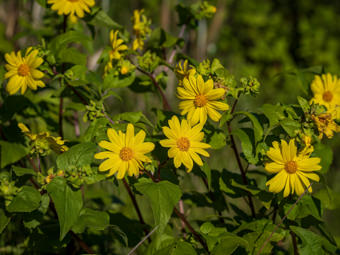
| Common Name(s): | Rock Daisy |
| Scientific Name: | Perityle emoryi |
| Family: | Asteraceae (Sunflower) |
| Plant Type: | Annual |
| Size: | up to 60cm |
| Habitat: | Coastal Sage |
| Blooms: | March to October |
| Fire Response: | Germinate from Seed |
Rock Daisy or Perityle emoryi is native to California and has been found in the SouthWest, Mexico and there are reports of the plant in Chile and Peru. This plant is adapted to the crevices of cliffs and other rocky soils.
Most of us are familiar with Daisies so our first impressions of this plant are right. It is a Daisy but which one? At the same time you might be thinking of over easy fried eggs - I did see these before breakfast. Their cousins, the Sunflowers are much larger and have yellow petals. Other types of Asters have purple to pink disk florets. The small bright flowerheads are about one half inch in diameter, have bright white ray florets and a sunny yellow center. What sets these flowers apart is the large number of flowerheads in such a small area. They might not be the biggest of flowers but when you combine the quantity of flowers with their beauty - look out! These plants can be found in Pt. Mugu State Park on the Ray Miler Trail and the La Jolla Valley trail. They bloom from January to June. As the seeds in the center develop you can observe the center of the flowerhead to rise like a rounded cone. Oftentimes you can observe flowers in many states of growth on the same plant. If you study them carefully, you can see how the ray florets develop after the disk florets. If you are really paying attention you may notice that the disk florets have a four lobed corolla. An involucre of Bracts surround the flower providing structure for the disk florets to develop along with the rest of the flowerhead. As the ray florets fall off the flowers - the remaining buds look like little pots of gold.
Perityle emoryi is quite adaptive and variable in appearance. It is an annual herb growing up to 60 centimeters tall, has a small stem, brittle/delicate structure, and simple, or thick, branching, and sprawling. It is usually hairy and glandular in texture. The alternately arranged leaves have blades of various shapes which are toothed or divided into lobes which are then connected to the stalk via petioles. Petioles is the precise way to describe how the leaf blade connects to the plant.
Milt's book says this plant is rare in our Santa Monicas. I have seen it the last couple of years - likely because of the Springs fire of 2013.
Link to Calflora.net - the best source of this fascinating information
Name Origin Collin'sia: named for Zaccheus Collins (1764-1831), a minerologist and botanist
heterophyl'la/heterophyl'lum/heterophyl'lus: means that the leaves are different on the same plant
Contributed by George Sherman
Aster diagram provided by Jenn Deutscher
Link to the artist's website
































